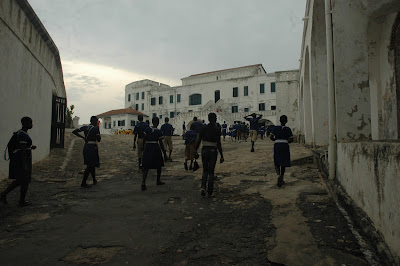 |
| The Cape Coast Castle |
This summer, as part of GHEI Summer Serve and Learn volunteer
program (that is now accepting applications!
Apply here!), volunteers will have a trip to Cape Coast Castle included
as part of their volunteering time with GHEI.
The Cape Coast Castle is a must visit for any traveller in
Ghana. This haunting and important
landmark is a UNESCO World Heritage Site, and is very popular with tourists. Until the 1830's, when Britain outlawed slave trading in its empire, captured men, woman and children from throughout
Ghana and other parts of Africa were marched hundreds of kilometres to this
point. Once they arrived at the castle, they were kept in a cramped dungeon for months until they were led aboard ships destined for the Americas, where they would work as slaves.
Phillip Briggs, who wrote the write up for Ghana on respected
travel publication Frommer's list of top ten places to visit in 2012, and also authored the Bradt Guide to Ghana, has this
to say about the castle, “This World Heritage Site
is reputed to have been one of the largest slave-holding sites in the world
during the colonial era...Sited on the edge of town overlooking a rocky stretch
of coast with crashing waves, this white washing building is far more
attractive than you feel a place with its history out to be. But once below ground, in the claustrophobic
dungeons which saw ten of thousands...it is a grim and sobering place indeed.” (Bradt Guide: Ghana.Vol.3)
 |
| View of Cape Coast town with its multitudes of colorful fishing vessels |
When I was there, I felt the same sort of odd juxtaposition
in Cape Coast. There were beautiful palm
lined beaches right under the chilling shadow of the Castle. In town, I was struck by how the reminders of
the colonial era existed in some strange harmony with the modern Ghana.
Walking next to a large European cathedral with a small cobblestone square, you were still surrounded by the chop bars, provision stores, and the boisterousness that you see in every Ghanaian city. It was an unforgettable vibe; it was beautiful and fascinating.
Walking next to a large European cathedral with a small cobblestone square, you were still surrounded by the chop bars, provision stores, and the boisterousness that you see in every Ghanaian city. It was an unforgettable vibe; it was beautiful and fascinating.
 |
| At the base of the castle, fisherman prep for a voyage out onto the waves |
Although this place is so important in world history, it is
nearly impossible for your average Ghanaian school child to visit it. GHEI provided their Youth Education Program
kids a chance to do just that though.
For the annual “Youth Learning Tour” (a.k.a a good old field trip), GHEI
students took a trip to the Kakum National Forest, the university of Cape
Coast, and finally, a trip to the Cape Coast Castle, and the beach next
door. For all it was their first time to
Cape Coast, for some, it was their first time seeing the ocean. We posted a slide show from the trip on our blog back in February.
 |
| YEP students at the castle |
They left Humjibre on a bus Friday, Febrauary 18'th, at 2
A.M, such was the fullness of the days events.
Education Program Coordinator Jen Artibello remembers well, “The bus
ride was an adventure all in itself! The bus we had booked did not show up and
we ended up with a smaller bus with less seats! Which was no problem as
everyone just shared seats, but the road we took to Cape Coast was mostly a
dirt road and looked like swiss cheese!” (Note: This is NOT the road
volunteers will take!)
At Kakum National Park, the canopy walk was quite popular but
very scary for most. The university was
also interesting, especially the computer lab. Few students had ever seen that
many computers. But no one was that
engaged.
 |
| GHEI students taking in the ocean's expanse |
At the Cape Coast Castle though, there were questions about
just about everything. “Most of the
students have never seen the ocean and I got many questions about that!” according
to Jen. “I was also asked numerous times what 'the big black things' were.
I explained they are cannons and then I had to explain what those were
and why they were there in the first place.”
The reason this place was built in such a fortified way was
not to ensure slaves didn't escape. It
was to protect the British interests.
The slaves and stores of gold in the Castle were often under siege from
pirates or other countries' navys. There are a
lot of cannons high on these walls.
 |
| Getting a better view |
“After the tour of the
dungeons we were all quiet and standing there staring out at the ocean.
Remember, this was the first time they had seen the ocean before, and they were
in awe.” according to Jen. “I asked one of my students what he thought of the
ocean. He didn’t say anything; he just started to cry! He couldn’t come up with
any words.”
After exploring the castle on their own a bit more, staff and
students went down to the beach. “After an eventful day of firsts, running away
from waves while screaming and laughing was definitely the highlight of the
trip for them! It was a great day and I know the students learned so much more than they would have if they were in a classroom.”
Volunteer this summer with GHEI in Humjibre and learn more about an
important piece of history in a beautiful part of the world.


